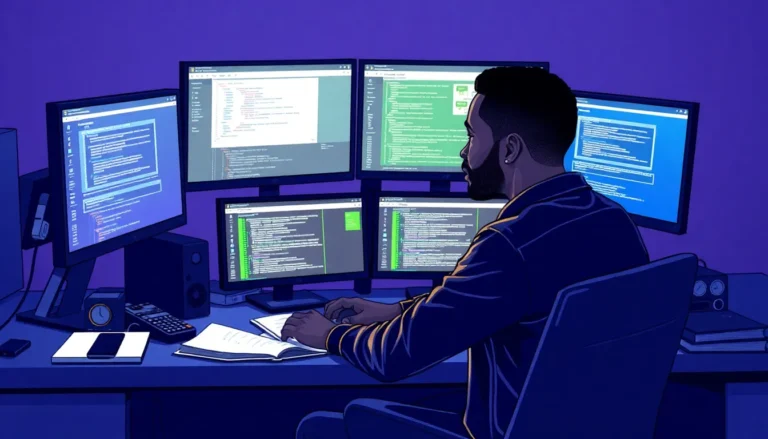Table of Contents
ToggleIn the ever-evolving world of web development, choosing the right framework can feel like picking a favorite child—impossible! Enter Laravel, the superhero of PHP frameworks, swooping in to save the day with its elegant syntax and robust features. Whether you’re a seasoned developer or just dipping your toes into the coding pool, Laravel tutorials are your trusty sidekick on this thrilling adventure.
Overview of Laravel Tutorials
Laravel tutorials serve as an essential resource for individuals looking to master this powerful PHP framework. Learning paths often include video tutorials, written documentation, and hands-on projects, catering to various learning styles. Beginners find value in step-by-step guides that cover foundational concepts, while experienced developers can explore advanced topics such as package development and API integration.
Structured tutorials keep information clear and concise. For instance, developers might focus on specific features, such as routing, middleware, and Eloquent ORM. Each feature often has dedicated sections, ensuring in-depth understanding and practical application. Interactive platforms, like Laracasts, offer real-world scenarios that enhance learning experiences.
Tutorials frequently address best practices. Coding standards, efficient debugging techniques, and Laravel’s built-in tools are common themes. By honing skills in these areas, developers improve their coding efficiency and contribute to better project outcomes. Additionally, community forums and discussion boards provide support and real-time interaction, fostering collaborative learning.
Many tutorials emphasize the importance of version control. Integrating Git into the development workflow helps streamline collaboration and code management. Exploring tools like Laravel Mix and Artisan commands also gets included, offering insights into optimizing development processes.
Laravel tutorials equip learners with the knowledge and skills necessary for effective web development. Beginners should start with fundamental courses, whereas advanced users can dive into specialized topics. Combining different formats ensures comprehensive learning and prepares individuals for success in their coding endeavors.
Popular Laravel Tutorials
Laravel tutorials cater to a variety of skill levels, enhancing both foundational and advanced knowledge. They provide essential insights into the framework’s functionalities.
Beginner Tutorials
Beginner tutorials focus on core concepts, laying a solid groundwork in Laravel. Step-by-step guides often introduce routing, middleware, and Eloquent ORM for database management. Video series available on platforms like YouTube engage learners visually, while written documentation offers precise explanations. Hands-on projects empower beginners to apply theory practically. Free resources such as Laravel’s official documentation and community forums also support early learners effectively.
Advanced Tutorials
Advanced tutorials dive into complex topics within the Laravel ecosystem. These resources often explore package development, RESTful API creation, and integration with third-party services. In-depth articles and video courses enable experienced developers to enhance their skills. Topics like performance optimization and security practices yield significant insights. Many advanced tutorials are found in specialized forums and premium course platforms, offering valuable knowledge for those wishing to master the framework’s intricacies.
Best Platforms for Laravel Tutorials
Numerous platforms offer high-quality Laravel tutorials suitable for different learning preferences. Exploring these options can enhance the learning experience and provide valuable insights.
Online Courses
Prominent platforms offer comprehensive online courses for Laravel. Websites like Udemy and Coursera feature structured curriculum covering everything from basic concepts to advanced techniques. These courses often include interactive quizzes and assignments that reinforce learning. Instructors provide in-depth explanations, ensuring learners grasp essential skills effectively. Additionally, platforms like Laracasts focus specifically on Laravel, delivering targeted tutorials for varying skill levels. Learning becomes systematic with video lectures that break down complex topics efficiently. Many of these courses also include downloadable resources, enabling users to practice coding independently.
YouTube Channels
YouTube hosts numerous channels dedicated to Laravel tutorials. Channels like Traversy Media and Academind present engaging video series that cover a range of topics, making learning accessible and enjoyable. Viewers can find walkthroughs, live coding sessions, and project-based tutorials that bring theory to life. A community often forms around these channels, allowing learners to ask questions and share insights. Content creators frequently update their videos to align with the latest version of Laravel, ensuring relevance. Engaging presentation styles make these tutorials appealing and easy to follow, enhancing both retention and application of concepts.
Key Features of Laravel
Laravel stands out due to its elegant syntax, which enhances overall development speed. The framework provides a rich set of functionalities, making it ideal for building modern web applications. Routing is intuitive, enabling developers to create clean URLs effortlessly.
Eloquent ORM offers a powerful database abstraction layer that streamlines data manipulation. Developers appreciate its active record implementation, simplifying complex queries. Migration systems facilitate easy database version control, ensuring consistency across development environments.
Built-in authentication options enhance security, allowing developers to implement user authentication with minimal effort. The framework also includes routing middleware, enabling developers to manage requests with precision.
Blade, Laravel’s templating engine, offers a clean syntax that promotes reusability and modularity. Custom directives can be created, which extends functionality and improves maintainability. Feature-rich libraries, like Laravel Mix, streamline asset management, simplifying CSS and JavaScript compilation.
Artisan command-line tool empowers developers to automate repetitive tasks easily. Creating controller templates, running migrations, and testing applications become straightforward processes. Real-time event broadcasting using Laravel Echo enhances interactivity, allowing applications to respond dynamically to user actions.
Laravel’s modular packaging system promotes code reusability through its package management system. This feature enables developers to integrate third-party libraries without complications. A vibrant community supports Laravel, with numerous resources available for troubleshooting and learning.
Ultimately, the combination of these features makes Laravel a robust solution for web development. Developers gain a comprehensive toolkit, facilitating both rapid prototyping and full-featured application development.
Conclusion
Laravel stands out as a powerful PHP framework that caters to developers of all skill levels. With a wealth of tutorials available, learners can easily find resources that match their preferred learning style. Whether through engaging video content or detailed written guides, the opportunities to master Laravel are abundant.
The framework’s elegant syntax and robust features simplify the development process, making it an ideal choice for both beginners and seasoned programmers. By leveraging the diverse range of tutorials and community support, developers can enhance their skills and build impressive applications with confidence. Embracing Laravel not only equips developers with essential tools but also fosters a deeper understanding of modern web development practices.









